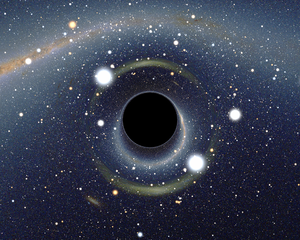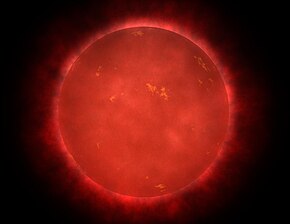IntroductionA star is a luminous spheroid of plasma held together by self-gravity. The nearest star to Earth is the Sun. Many other stars are visible to the naked eye at night; their immense distances from Earth make them appear as fixed points of light. The most prominent stars have been categorised into constellations and asterisms, and many of the brightest stars have proper names. Astronomers have assembled star catalogues that identify the known stars and provide standardized stellar designations. The observable universe contains an estimated 1022 to 1024 stars. Only about 4,000 of these stars are visible to the naked eye—all within the Milky Way galaxy. A star's life begins with the gravitational collapse of a gaseous nebula of material largely comprising hydrogen, helium, and trace heavier elements. Its total mass mainly determines its evolution and eventual fate. A star shines for most of its active life due to the thermonuclear fusion of hydrogen into helium in its core. This process releases energy that traverses the star's interior and radiates into outer space. At the end of a star's lifetime as a fusor, its core becomes a stellar remnant: a white dwarf, a neutron star, or—if it is sufficiently massive—a black hole. Stellar nucleosynthesis in stars or their remnants creates almost all naturally occurring chemical elements heavier than lithium. Stellar mass loss or supernova explosions return chemically enriched material to the interstellar medium. These elements are then recycled into new stars. Astronomers can determine stellar properties—including mass, age, metallicity (chemical composition), variability, distance, and motion through space—by carrying out observations of a star's apparent brightness, spectrum, and changes in its position in the sky over time. Stars can form orbital systems with other astronomical objects, as in planetary systems and star systems with two or more stars. When two such stars orbit closely, their gravitational interaction can significantly impact their evolution. Stars can form part of a much larger gravitationally bound structure, such as a star cluster or a galaxy. (Full article...) Selected star - Photo credit: NASA
Eta Carinae (η Carinae or η Car) is a stellar system in the constellation Carina, about 7,500 to 8,000 light-years from the Sun. The system contains at least two stars, one of which is a Luminous Blue Variable (LBV), which during the early stages of its life had a mass of around 150 solar masses, of which it has lost at least 30 since. It is thought that a Wolf–Rayet star of approximately 30 solar masses exists in orbit around its larger companion star, although an enormous thick red nebula surrounding Eta Carinae makes it impossible to see optically. Its combined luminosity is about four million times that of the Sun and has an estimated system mass in excess of 100 solar masses. It is not visible north of latitude 30° N and is circumpolar south of latitude 30° S. Because of its mass and the stage of life, it is expected to explode in a supernova or even hypernova in the astronomically near future. Eta Carinae has the traditional names Tseen She (from the Chinese 天社 [Mandarin: tiānshè] "Heaven's altar") and Foramen. In Chinese, 海山 (Hǎi Shān), meaning Sea and Mountain, refers to an asterism consisting of η Carinae, s Carinae, λ Centauri and λ Muscae. This stellar system is currently one of the most massive that can be studied in great detail. Until recently, Eta Carinae was thought to be the most massive single star, but in 2005 it was realised to be a binary system. The most massive star in the Eta Carinae multiple star system has more than 100 times the mass of the Sun. Other known massive stars are more luminous and more massive. Selected article - Photo credit: User:Alain r
According to the general theory of relativity, a black hole is a region of space from which nothing, including light, can escape. It is the result of the deformation of spacetime caused by a very compact mass. Around a black hole there is an undetectable surface which marks the point of no return, called an event horizon. It is called "black" because it absorbs all the light that hits it, reflecting nothing, just like a perfect black body in thermodynamics. Under the theory of quantum mechanics black holes possess a temperature and emit Hawking radiation. Despite its invisible interior, a black hole can be observed through its interaction with other matter. A black hole can be inferred by tracking the movement of a group of stars that orbit a region in space. Alternatively, when gas falls into a stellar black hole from a companion star, the gas spirals inward, heating to very high temperatures and emitting large amounts of radiation that can be detected from earthbound and Earth-orbiting telescopes. Astronomers have identified numerous stellar black hole candidates, and have also found evidence of supermassive black holes at the center of galaxies. After observing the motion of nearby stars for 16 years, in 2008 astronomers found compelling evidence that a supermassive black hole of more than 4 million solar masses is located near the Sagittarius A* region in the center of the Milky Way galaxy. Selected image - Photo credit: NASA/Walt Feimer
According to the Hertzsprung-Russell diagram, a red dwarf is a small and relatively cool star, of the main sequence, either late K or M spectral type. They constitute the vast majority of stars and have a mass of less than half that of the Sun (down to about 0.075 solar masses, which are brown dwarfs) and a surface temperature of less than 4,000 K. Did you know?
SubcategoriesTo display all subcategories click on the ►
Selected biography -Subrahmanyan Chandrasekhar, FRS (/ˌtʃʌndrəˈʃeɪkɑːr/ ; Tamil: சுப்பிரமணியன் சந்திரசேகர்; October 19, 1910 – August 21, 1995) was an Indian-American astrophysicist who, with William A. Fowler, won the 1983 Nobel Prize for Physics for key discoveries that led to the currently accepted theory on the later evolutionary stages of massive stars. Chandrasekhar was the nephew of Sir Chandrasekhara Venkata Raman, who won the Nobel Prize for Physics in 1930. Chandrasekhar's most notable work was the astrophysical Chandrasekhar limit. The limit describes the maximum mass of a white dwarf star, ~ 1.44 solar mass, or equivalently, the minimum mass above which a star will ultimately collapse into a neutron star or black hole (following a supernova). The limit was first calculated by Chandrasekhar in 1930 during his maiden voyage from India to Cambridge, England, for his graduate studies. In 1999, the NASA named the third of its four "Great Observatories" after Chandrasekhar. The Chandra X-ray Observatory was launched and deployed by Space Shuttle Columbia on July 23, 1999. The Chandrasekhar number, an important dimensionless number of magnetohydrodynamics, is named after him. The asteroid 1958 Chandra is also named after Chandrasekhar. American astronomer Carl Sagan, who studied Mathematics under Chandrasekhar, at the University of Chicago, praised him in the book The Demon-Haunted World: "I discovered what true mathematical elegance is from Subrahmanyan Chandrasekhar." From 1952 to 1971 Chandrasekhar also served as the editor of the Astrophysical Journal. He was awarded the Nobel Prize in Physics in 1983 for his studies on the physical processes important to the structure and evolution of stars. Chandrasekhar accepted this honor, but was upset that the citation mentioned only his earliest work, seeing it as a denigration of a lifetime's achievement. He shared it with William A. Fowler.
TopicsThings to do
Related portalsAssociated WikimediaThe following Wikimedia Foundation sister projects provide more on this subject:
Discover Wikipedia using portals |
























